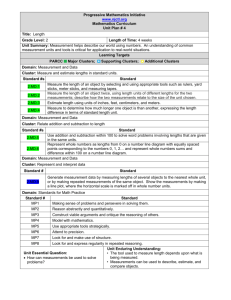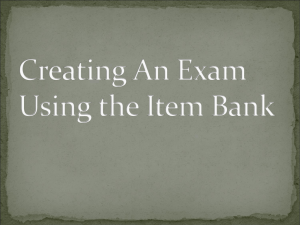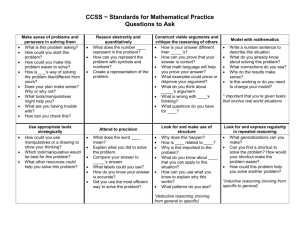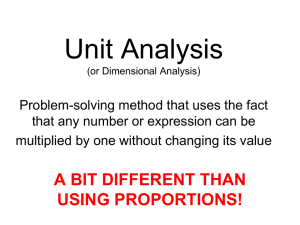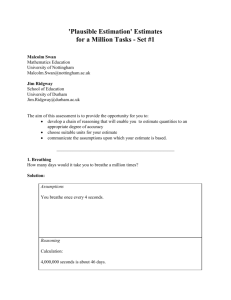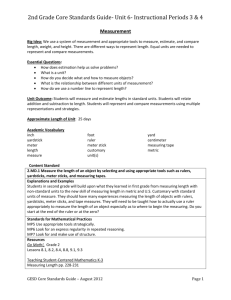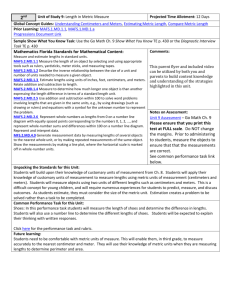Unit 9 (Topic 15): Length
advertisement
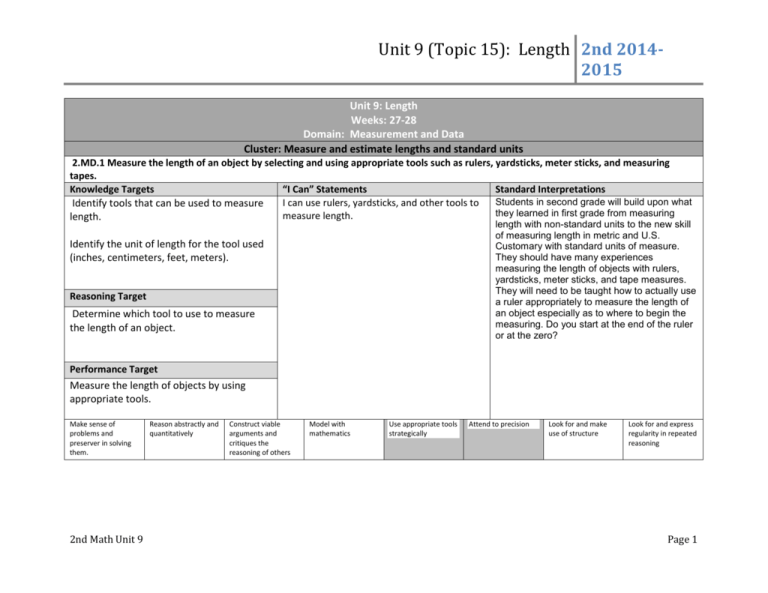
Unit 9 (Topic 15): Length 2nd 20142015 Unit 9: Length Weeks: 27-28 Domain: Measurement and Data Cluster: Measure and estimate lengths and standard units 2.MD.1 Measure the length of an object by selecting and using appropriate tools such as rulers, yardsticks, meter sticks, and measuring tapes. Knowledge Targets “I Can” Statements Standard Interpretations Students in second grade will build upon what I can use rulers, yardsticks, and other tools to Identify tools that can be used to measure they learned in first grade from measuring measure length. length. length with non-standard units to the new skill of measuring length in metric and U.S. Customary with standard units of measure. They should have many experiences measuring the length of objects with rulers, yardsticks, meter sticks, and tape measures. They will need to be taught how to actually use a ruler appropriately to measure the length of an object especially as to where to begin the measuring. Do you start at the end of the ruler or at the zero? Identify the unit of length for the tool used (inches, centimeters, feet, meters). Reasoning Target Determine which tool to use to measure the length of an object. Performance Target Measure the length of objects by using appropriate tools. Make sense of problems and preserver in solving them. 2nd Math Unit 9 Reason abstractly and quantitatively Construct viable arguments and critiques the reasoning of others Model with mathematics Use appropriate tools strategically Attend to precision Look for and make use of structure Look for and express regularity in repeated reasoning Page 1 Unit 9 (Topic 15): Length 2nd 20142015 Cluster: Measure and estimate lengths and standard units 2.MD.2 Measure the length of an object twice, using length units of different lengths for the two measurements; describe how the two measurements relate to the size of the unit chosen. Knowledge Targets I can measure the length of an object two Standard Interpretations Students need multiple opportunities to ways using different units of measurement. Know how to measure the length of objects measure using different units of measure. with different units They should not be limited to measuring within the same standard unit. Students should have access to tools, both U.S.Customary and metric. The more students work with a specific unit of measure, the better they become at choosing the appropriate tool when measuring. Students measure the length of the same object using different tools (ruler with inches, ruler with centimeters, a yardstick, or meter stick). This will help students learn which tool is more appropriate for measuring a given object. They describe the relationship between the size of the measurement unit and the number of units needed to measure something. For instance, a student might say, “The longer the unit, the fewer I need.” Multiple opportunities to explore provide the foundation for relating metric units to customary units, as well as relating within customary (inches to feet to yards) and within metric (centimeters to meters). Reasoning Targets Compare measurements of an object taken with two different units. Describe why the measurements of an object taken with two different units are different. Explain the length of an object in relation to the size of the units used to measure it. Make sense of problems and preserver in solving them. 2nd Math Unit 9 Reason abstractly and quantitatively Construct viable arguments and critiques the reasoning of others Model with mathematics Use appropriate tools strategically Attend to precision Look for and make use of structure Look for and express regularity in repeated reasoning Page 2 Unit 9 (Topic 15): Length 2nd 20142015 Cluster: Measure and estimate lengths and standard units 2.MD.3 Estimate lengths using units of inches, feet, centimeters, and meters. Knowledge Targets “I Can” Statements I can estimate lengths using inches, feet, Know strategies for estimating length. centimeters, and meters. Recognize the size of inches, feet, centimeters, and meters. Reasoning Target Determine if estimate is reasonable. Performance Target 2nd Math Unit 9 Reason abstractly and quantitatively Construct viable arguments and critiques the reasoning of others Estimation helps develop familiarity with the specific unit of measure being used. To measure the length of a shoe, knowledge of an inch or a centimeter is important so that one can approximate the length in inches or centimeters. Students should begin practicing estimation with items which are familiar to them (length of desk, pencil, favorite book, etc.). Some useful benchmarks for measurement are: First joint to the tip of a thumb is about an inch Length from your elbow to your wrist is about a foot If your arm is held out perpendicular to your body, the length from your nose to the tip of your fingers is about a yard Estimate lengths in units of inches, feet, centimeters, and meters. Make sense of problems and preserver in solving them. Standard Interpretations Model with mathematics Use appropriate tools strategically Attend to precision Look for and make use of structure Look for and express regularity in repeated reasoning Page 3 Unit 9 (Topic 15): Length 2nd 20142015 Cluster: Measure and estimate lengths and standard units 2.MD.4 Measure to determine how much longer one object is than another, expressing the length difference in terms of a standard length unit. Knowledge Targets “I Can” Statements Standard Interpretations Second graders should be familiar enough with I can measure to see how much longer one Name standard length units. inches, feet, yards, centimeters, and meters to object is than another. be able to compare the differences in lengths of two objects. They can make direct comparisons by measuring the difference in length between two objects by laying them side by side and selecting an appropriate standard length unit of measure. Students should use comparative phrases such as “It is longer by 2 inches” or “It is shorter by 5 centimeters” to describe the difference between two objects. An interactive whiteboard or document camera may be used to help students develop and demonstrate their thinking. Reasoning Target Compare lengths of two objects. Determine how much longer one object is than another in standard length units. Performance Target Make sense of problems and preserver in solving them. 2nd Math Unit 9 Reason abstractly and quantitatively Construct viable arguments and critiques the reasoning of others Model with mathematics Use appropriate tools strategically Attend to precision Look for and make use of structure Look for and express regularity in repeated reasoning Page 4 Unit 9 (Topic 15): Length 2nd 20142015 Cluster: Measure and estimate lengths and standard units 2.MD.5 Use addition and subtraction within 100 to solve word problems involving lengths that are given in the same units, e.g., by using drawings (such as drawings of rulers) and equations with a symbol for the unknown number to represent the problem. Knowledge Targets “I Can” Statements Standard Interpretations I can add and subtract to solve word problems Students need experience working with addition and Add and subtract lengths within 100. subtraction to solve word problems which include about lengths. measures of length. It is important that word Reasoning Target Solve word problems involving lengths that are given in the same units. Solve word problems involving length that have equations with a symbol for the unknown number. Performance Target problems stay within the same unit of measure. Counting on and/or counting back on a number line will help tie this concept to previous knowledge. Some representations students can use include drawings, rulers, pictures, and/or physical objects. An interactive whiteboard or document camera may be used to help students develop and demonstrate their thinking. Equations include: 20 + 35 = c c - 20 = 35 c – 35 = 20 20 + b = 55 35 + a = 55 55 = a + 35 55 = 20 + b Example: A word problem for 5 – n = 2 could be: Mary is making a dress. She has 5 yards of fabric. She uses some of the fabric and has 2 yards left. How many yards did Mary use? There is a strong connection between this standard and demonstrating fluency of addition and subtraction facts. Addition facts through 10 + 10 and the related subtraction facts should be included. 2nd Math Unit 9 Page 5 Unit 9 (Topic 15): Length 2nd 20142015 Make sense of problems and preserver in solving them. Reason abstractly and quantitatively Construct viable arguments and critiques the reasoning of others Model with mathematics Use appropriate tools strategically Attend to precision Look for and make use of structure Look for and express regularity in repeated reasoning Vocabulary Unit Length Inch (in.) Width Height Nearest Inch Centimeter (cm) Nearest Centimeter Foot (ft) Yard (yd) Meter (m) 2nd Math Unit 9 Page 6

